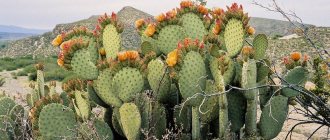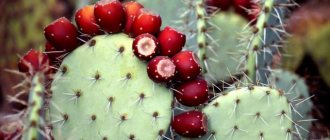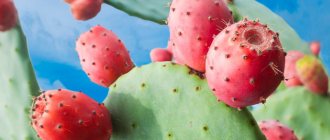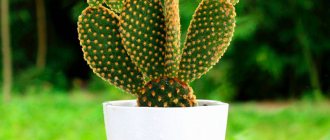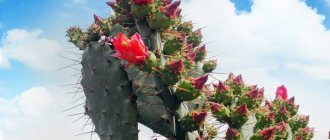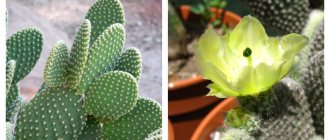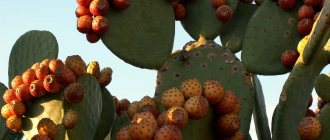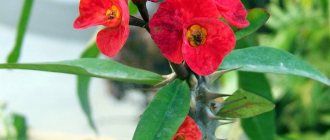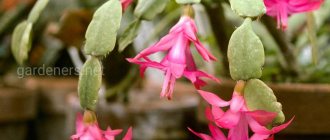Everyone knows this hardy cactus with edible fruits. Prickly pear has flat, succulent shoots of round or oval shape, like ears or flat cakes. They grow from one another at different angles, forming bizarre silhouettes. It happens that a traveler who finds himself in such thickets finds it very difficult to get out of there.
The shoots of prickly pear, like all cacti, have halos - highly modified axillary buds with long sharp spines and bunches of thin spines - glochidia. These villi are very insidious. They have serrations at the ends, like an arrowhead. When they come into contact with the skin, they break off and attach to it, causing irritation and itching.
Prickly pear flowers are solitary, sessile, large and showy, reminiscent of roses. The color is white, yellow, orange, red in different shades.
The fruits are large, juicy and also have spines on the outside. Collect them using thick gloves. The seeds are dark, round, with a hard shell (1).
In tropical and subtropical climates, prickly pear is grown as a food and fodder plant - it is a favorite delicacy of donkeys. Young shoots, cleared of thorns and glochidia, are used as vegetables - fresh, fried, baked, pickled. Large sweet fruits, despite the difficulty of peeling them, as well as the large number of seeds hard as shot, are a delicacy in many countries. They are used to prepare molasses, preserves, raw jam, marmalade, marshmallows, dried fruits, drinks - syrup, juice and wine. On the island of Malta, several companies produce the signature aromatic liqueur Bajtra from prickly pear fruits, which tourists take with them.
Opuntia is not without medicinal properties. The juice of some of its species has a wound-healing effect. Fleshy shoots are used in folk medicine for compresses and in the treatment of burns.
Inside old prickly pear shoots there is non-rotting wood - strong, but at the same time porous and twisted. Candlesticks, handles, and polished jewelry are made from it.
In ornamental gardening, prickly pear is used in landscape compositions in gardens and parks, and also as hedges.
Prickly pears have been known as a houseplant since the beginning of the 18th century, but indoors they bloom reluctantly and only under favorable conditions, and, as a rule, do not produce fruit. However, in winter gardens and wall-mounted heated greenhouses of cottages and country houses, their chances for the full life cycle of shoots are noticeably increased, especially with additional lighting (2).
Young plants usually bloom at 10 years of age or older.
Interesting fact According to ancient legend, the Aztecs, tired of long wanderings in the mountains, stopped on the shore of the beautiful Lake Texcoco and saw an eagle tearing apart a snake on a large prickly pear tree. This was a good sign from the gods and the tribe founded the city of Tenochtitlan here - “Place of the Sacred Prickly Pear” - present-day Mexico City. Now this scene from the legend is depicted on the Mexican coat of arms.
Types of prickly pear
More than 350 species of prickly pear are known in nature. But only a few of them are used in culture.
Opuntia microdasys. Compact branching plant up to 60 cm high for indoor floriculture. The stem consists of oval dark green segments up to 15 cm long with numerous halos-pads of brightly colored glochidia - yellow, red and pearly white (form Albinospina ). The flowers are yellow. The fruits are large red.
Berger's prickly pear (Opuntia bergeriana). Grows up to 1 m. The shoots are elongated, light green, with long yellow spines. It blooms at an early age and profusely. The flowers are orange-red with a green pistil.
White-haired prickly pear (Opuntia leucotricha). The stem fragments are elongated - up to 25 cm. The peculiarity of this species is the long white spines with which all the shoots are densely dotted. The flowers are small, golden yellow.
Opuntia microdasys. Photo: globallookpress.com
Berger's prickly pear (Opuntia bergeriana). Photo: globallookpress.com
Cylindrical prickly pear (Opuntia cylindrica). Photo: globallookpress.com
Indian prickly pear, or fig (Opuntia ficus-indica). Photo: globallookpress.com
Cylindrical prickly pear (Opuntia cylindrica). Plants with cylindrical stems atypical for prickly pears are also called pterocacti.
Indian prickly pear, or fig (Opuntia ficus-indica). The trunk becomes woody at the base. The shoots are olive green in color. Small aureoles contain numerous cream-colored spines. The flowers are bright amber, with a golden tint. In nature it produces a good harvest of very tasty and aromatic fruits.
Gosselin's prickly pear (Opuntia gosseliniana). Plants begin to bloom at 5 years of age. Young prickly pears have reddish shoots, while adults have blue-green shoots with a silvery tint. Only the upper part of the segments is strewn with soft long spines. The flowers are yellow and fragrant.
Caution doesn't hurt
These exotic fruits are delicious, but eat them in moderation. Otherwise, headaches, nausea, constipation and even hives may occur. It is better to eat more than one fruit per day. Also keep in mind that some people are not predisposed to eating this delicacy at all.
Prickly pear fruits are sold for sale in a thorn-free form, but glochidia may still remain on them. Therefore, be sure to rinse store-bought berries under a strong stream of water and then wipe with a thick towel.
In addition to direct consumption, the product can be used as an addition to various dishes and desserts. What else can you make from prickly pear fruits? If you fry them in a sweet fruit sauce, you get a wonderful delicacy. The pulp can be added to any fruit salads and made into excellent jam.
It is also interesting that the fruits of the prickly pear cactus are in perfect harmony with meat dishes. Try adding them to your favorite recipe or using them as an ingredient in your cooking process.
Olga Danilina
Caring for prickly pear at home
Prickly pear is easy to grow and adapts well to different conditions. In the summer, it is advisable to move her to fresh air - to a balcony or even to a dacha. During the budding and flowering phase, plants cannot be moved from place to place, as this may cause the flowers to fall off (3).
Priming
For prickly pears, special soils for cacti and succulents or a soil mixture of the following composition are suitable: turf soil, coarse sand, fine crushed stone or expanded clay (2:3:1) with the addition of clay (4).
Lighting
Large, healthy prickly pear plants are formed only under intense light. The ideal place is a south-facing window or close to it, protected from direct sunlight (4).
Photo: pixabay.com
Temperature
In winter, prickly pears are kept at a temperature of 5–15 °C and low soil and air humidity. At higher temperatures, plants stretch and weaken.
In summer, the favorable temperature is 23 – 30 °C, but in principle plants tolerate a wide range of positive temperatures (4).
Humidity
Cacti are exceptionally drought-resistant and even at home can live for a long time without irrigation. Therefore, water them abundantly, but rarely:
- during the growth period - once every 10 - 15 days, depending on the temperature and drying of the soil;
- in winter - once every 20 - 25 days (before the next watering, the soil must dry out; at low temperatures, watering is stopped).
Use only soft, settled water. Watering should be done from a watering can along the edge of the pot so that water does not fall on the plants.
And, oddly enough, prickly pears, and other cacti too, love spraying, since in nature they are covered with tiny drops of dew every morning. Therefore, they need to be sprayed from time to time. You will need a fine spray bottle. The can is filled with warm water (30 – 35 °C), and when sprayed, it cools.
The room where prickly pear grows must be regularly ventilated (4).
Fertilizers and fertilizers
Opuntias, like most cacti, are fed once a month from spring to late summer with complex mineral fertilizers for cacti and succulents or liquid fertilizer for cacti. Organic fertilizers are not suitable for these desert dwellers. Solutions are prepared according to instructions.
In autumn, fertilization is stopped (2).
Trimming
Regular pruning of prickly pear is not required. It is carried out only when the cactus needs help, or to change the appearance of the plant by giving it a beautiful shape or simply reducing it in size. Shoots that have stretched out after winter are often pruned (2).
How to Promote Prickly Pear Flowering
Prickly pear rarely blooms at home, but some gardeners manage to get flowers from this cactus.
A wide pot is considered the key to abundant flowering. It is also recommended to place the prickly pear cactus outside (balcony or garden plot) for the entire growing season. At the same time, it is important to move the pot with the plant as little as possible - choose a permanent outdoor place for it, having previously taken care of protection from strong winds and precipitation. The prickly pear should be accustomed to the outdoor sun gradually, initially by slightly shading it and allowing only short-term direct lighting. Dry wintering can also have a beneficial effect on the flowering process in mid-summer.
If buds finally appear on the prickly pear, success is already close and it is important not to “scare it off” with fussy actions. There is no need to rearrange and rotate the pot with the plant (it is better to touch it as little as possible), there is no need to replant the cactus, water it more often or more than usual, or additionally fertilize the soil. Because of this, prickly pear may drop its buds. Do not disturb her, and then the flowers will certainly bloom.
Reproduction of prickly pear at home
By cuttings. This is the main way. Young shoots are cut off at the point of origin, dried in the shade for 1 - 3 days and planted for rooting, slightly buried, in a sterilized mixture of peat and sand (1:1). The substrate is slightly moistened, and the container with plants is covered with a thin film or non-woven fabric on the frame. The temperature is maintained at 20 °C.
When new buds appear on the cuttings, it is transplanted into a permanent pot.
Seeds. Prickly pear seeds have a very hard shell, so before sowing they need to be scarified - make small cuts with a nail file. Then the seeds are soaked for 30 minutes in a pink solution of potassium permanganate and then another 12 hours in warm water, washing it several times. After such preparation, the seeds are sown in dry soil of the same composition and the container is covered with glass. Next, the substrate is periodically sprayed. The temperature is maintained at 22 °C.
Photo: pixabay.com
The emergence of seedlings can take up to a month and it is important that the seeds do not rot. Grown seedlings dive into small pots (2).
How to touch an overseas berry
Do not handle any parts of the edible cactus with your bare hands, as the spines are very sharp. In addition, on the surface of the plant there are very small glochidia (remember what they are called!) - these are the same spines, but not visible to the eye.
These tricky spines are also covered with delicate fluff. When they enter the esophagus, they dig into the mucous membrane, and it is impossible to remove them without the help of a doctor. Worse, in this case the inflammatory process immediately begins.
You need to wear rubber gloves to get rid of spines and glochidia. You can clean the stems and fruits of prickly pear from spines and glochidia in three ways:
- Under a strong stream of water, followed by thorough wiping.
- Freezing and rubbing.
- Burning over an open flame.
Process the thorn-free fruits before eating; it’s not difficult. Hold the fruit with a fork, cut off the top and bottom with a sharp knife and cut it lengthwise into two halves.
After this, the skin is easily separated from the pulp. You can eat the pulp with a spoon along with the seeds, as they contain many useful substances (seed oil is very valuable). In this case, you don’t have to remove the skin.
Transplanting prickly pear at home
Young prickly pears are replanted every year or every other year, adults - once every 4 - 5 years, as they grow or when the substrate is depleted.
Replanting cacti is much easier than other indoor plants; their roots are easily freed from the soil and their survival rate is usually high.
The best time to transplant is at the end of winter. Watering should be stopped a week in advance. The diameter of the new pot should be 2–3 cm larger than the previous one. Plants are buried to the level of the root collar.
Transplantation can be alternated with transshipment into larger containers while preserving the earthen clod.
Transplanted plants begin to be watered after 10 – 12 days (5).
Benefits of cactus berries
The beneficial properties of the queen of cacti have long been beyond doubt. This wonder is recommended for obese people - the plant extract is included in weight loss medications. Berries have a beneficial effect on the stomach and intestines. They promote the production of insulin, which is why they are recommended for people with diabetes.
The pulp of the fruit tones and quenches thirst. The decoction can even lower high temperatures.
If you wish, you can make jam, jam, liqueurs, marmalades, candied fruits and all kinds of sauces from the fruits and stems of prickly pear. Plant stems no more than 1 cm thick are suitable for food. You can also add them to salads.
The stems, unlike the fruits, are considered vegetables. They can be baked, stewed and boiled - this is an option to surprise your guests! How to store these berries? If frozen, some of the beneficial substances will disappear, but if dried, there will be more benefits.
Prickly pear diseases
Cacti are more susceptible to physiological - non-infectious diseases that develop under unfavorable conditions for plants. Stale air in a poorly ventilated area, high humidity in the air and soil, especially at low temperatures, contribute to the emergence and spread of diseases.
Main signs of ailments:
Brown spots on shoots. The reason is excessive watering.
The affected segments are cut down to healthy tissue and treated with crushed coal.
Shriveled leaves. This usually occurs due to lack of light or excess moisture.
It is recommended to move the plant to a brighter place and adjust watering.
Stopping growth. A consequence of excess moisture in winter and (or) deficiency of nutrients, including microelements.
Photo: pixabay.com
Proper watering and regular fertilizing will correct the situation.
Weakened plants can become infected with fungal diseases: blight (wet rot) and fomoz (dry rot). To protect against them, fungicides are used - Bordeaux mixture, Fundazol, Polychom (3).
Chemical composition and nutritional value of fruits
The fruits have different contents of active substances depending on the variety. The prickly pear berry contains enzymes, sterols, alkaloids, pigments, hormone-like substances, essential oils and even plant antibiotics.
Prickly pear is useful for obesity; with a low calorie content, it saturates the body with useful substances. 100 g of fruit contains:
- 40-42 kcal;
- 0.7 g proteins;
- 6 g carbohydrates;
- 0.5 g fat;
- 3.7 g fiber;
- 1.6 g of ash elements;
- 87.5 g water.
Prickly pear is a rich source of beta-carotene, vitamins - A, C, group B, mineral elements - potassium, magnesium, phosphorus, calcium, iron, zinc, copper, selenium. The composition contains polyunsaturated (omega), monounsaturated and saturated acids, the total content of which is 67 mg per 100 g.
Prickly pear pests
The main pests of prickly pear are spider mites and mealybugs; scale insects also readily settle on the shoots, and nematodes on the roots. Regular inspection of plants will allow you to immediately notice the appearance of pests and take action.
Spider mite. It multiplies quickly in dry, poorly ventilated areas. It feeds on plant cell sap, mainly on young shoots. With severe damage, prickly pears stop growing, and the color of the shoots changes to yellowish or reddish.
Acaricides are suitable for treatment: Neoron, Sunmite, etc. - according to the instructions.
Mealybug. When these small insects accumulate, the cacti seem to be sprinkled with flour. White lumps of oviposition are also clearly visible.
At the initial stage of infestation, insects and eggs can be washed off with a damp brush. Severely affected plants are treated with insecticides - Actellik, Fufanon (6), etc. and covered with plastic wrap for a day.
Against nematodes, the soil is watered twice, with an interval of 7–10 days, with nematicides (Vidat, Nematofagin-Mikopro, etc.), according to the instructions. Scale insects are mainly removed mechanically, and the shoots are then washed with a weak solution of potassium permanganate (3).
Interesting fact
In the recent past, in Mexico, entire prickly pear plantations were grown to breed the hairy aphid - cochineal, from which they obtained a valuable crimson dye - carmine. With the advent of synthetic dyes, the cultivation of cochineal has sharply decreased, but natural carmine is still used in the food and perfume industries, as well as in biochemical research and for staining histological preparations for study under a microscope.
Possible harm and contraindications
When consuming fruits, use moderation, otherwise constipation or intestinal stenosis will occur.
You cannot eat prickly pear if:
- tendency to food allergies;
- individual intolerance;
- chronic diseases of the urinary organs (also contraindicated – hemorrhoids).
During pregnancy, prickly pear can be beneficial and harmful if the fetus has not been introduced into the diet before and the body is unfamiliar with it. Therefore, it is better not to take risks. This also applies to children under 3 years of age.
Jumping Beans
Imagine: on the table in front of you there is a handful of green-brown beans, each of which is the size of a fingernail (7-10 mm). You take them in your hands, and suddenly - lo and behold! — they come to life and begin to bounce in their palms. But what makes the beans move? You can see the answer in the photo below. Cydia deshaisiana
moth caterpillar curled up comfortably inside one of the beans.
Leaf moth caterpillar Cydia deshaisiana
inside the jumping "bean"
of Sebastiania pavoniana
. Photo © Whitney Cranshaw from idtools.org
Because of their ability to move, the beans are called "Mexican jumping beans." Strictly speaking, these are not real beans, but parts of a tripartite capsule - the dry fruit of the Mexican shrub Sebastiania pavoniana
from the Euphorbiaceae family.
The female C. deshaisiana
lays her eggs on Sebastiana flowers in the spring.
Flowers of the Mexican shrub Sebastiania pavoniana
, on which moths lay their eggs. Photo © Francisco Fajardo from plantasdecolombia.com
When fruits form in place of flowers, yellowish larvae with a brown head emerge from the eggs. The caterpillars develop inside the fruits and actively feed on the still juicy pulp, gradually gnawing out the air cavity inside. After the end of the rainy season, in June-July, the dry fruits of Sebastiania finally ripen and fall to the ground, splitting into three parts.
Left
— unripe fruits of the shrub
Sebastiania pavoniana
.
Photo from swbiodiversity.org. On the right
are ripe fruits, split into three parts; each part is a two-leaf box. Photo © Nick Thomas from inland360.com
Each part is a two-leaf box with seeds or a caterpillar. And then the most amazing thing happens: those boxes in which the caterpillars have settled begin to move intensively! These are the legendary “Mexican jumping beans.” If you shake the ripe fruits near your ear, the seeds inside the boxes will rattle like a rattle, and the “beans” with caterpillars inside will remain silent: there are no seeds inside.
Sebastiania fruits jump in the palms and under the lamp. Inside the fruit, of course, there is a larva
But how and, most importantly, why do caterpillars make the “beans” jump? Sebastiana grows in the rocky deserts of several states in Mexico, where temperatures can range from 0°C at night to 56°C in the shade during the day. If fallen fruits with caterpillars are exposed to the scorching sun, their wall begins to heat up quickly. For the cidia larva, such a development of events threatens big problems - it risks overheating, getting dehydrated and dying. Therefore, when the temperature rises, the larva begins to actively move inside the “bean”, which leads to its movements. The caterpillar can crawl intensively inside the box, then its shelter will sway and move, although quite slowly. But more often the cydia is attached to the inner wall of the “bean” with silk threads, clinging to them with hooks on the hind abdominal legs. When heated, she bends her body and straightens it with force, hitting the wall of the “bean” with the front end of her body and causing the box to jump in the direction of the impact. Of course, the movements of the fruits are quite chaotic, but sooner or later they end up in the shade of a tree or are buried in the foliage. Then the box cools down and the caterpillar can “take a break.”
Fruits with caterpillars retain the ability to move for 6–8 months, after which they subside. The cydia weaves a silk cocoon inside the box and pupates. Before this, the prudent larva gnaws an almost perfectly round hole in the wall of the “bean”, leaving only a thin bridge.
On the left is the caterpillar Cydia deshaisiana
(side view).
Photo © Caroline Harding from padil.gov.au. On the right
is a “Mexican jumping bean” abandoned by a moth: the rounded hole through which the insect left the box is clearly visible. Photo from padil.gov.au
In February, a small (wingspan 8–10 mm) gray-brown moth pushes through the “door” and comes out. Adult insects live only a few days.
Left
— Exuvium of a pupa and hatched moth of
Cydia deshaisiana
next to the fruit of
Sebastiania pavoniana
.
On the right
is a close-up of an adult moth. Photo © Whitney Cranshaw from idtools.org
In Mexico, sebastiana is called yerba de la flecha.
- "grass for arrows." The milky sap of this shrub is poisonous and was once used to make arrows. However, Sebastiania fruits are non-toxic, although they are not used for food. When heated in the hands, the “beans” begin to move, which makes them a traditional favorite pastime of Mexican children. Over time, "jumping beans" gained worldwide fame and became a profitable business. They can be ordered online anywhere in the world, and export amounts to several million “beans” per year.
"Beans" jump from light to shadow
However, such a massive export of fruits does not cause any damage to the Sebastiania population: the plant is quite prolific, and only the boxes with caterpillars inside are selected for sale. The boxes collected for sale are poured onto an inclined surface, the fruits with cidia larvae inside begin to bounce and gradually roll down into a special container. The seed pods (without caterpillars) remain in place, are captured by the net and “discarded”. In order for Mexican beans to hop for several months, they are advised to be sprayed with water from time to time and stored in the dark. There is even a patented toy that includes a jumping Sebastiana fruit as a “motor”!
In 2006, twenty Mexican jumping beans with cidia larvae inside traveled to space in the company of four Madagascar hissing cockroaches Gromphadorhina portentosa
on the inflatable spacecraft Genesis I. At least a few larvae metamorphosed into adults.
Mexican jumping beans aren't the only "live" fruits. In the fruits of the South African tree Spirostachys africana
The moth caterpillars
Emporia melanobasis
.
Emporia causes the mature fallen pods of Spirotachys, dubbed the “jumping bean tree,” to move. The Vietnamese caterpillar Calindoea trifascialis
(family moths) does not parasitize fruits, but feeds on leaves of a tree of the genus
Dipterocarpus
. But when the time comes to pupate, the caterpillar builds a “tent” from a piece of leaf for this purpose. The “tent” falls to the ground, and the larva inside bends, hitting its wall and causing it to jump to a small height. Researchers believe that the caterpillar jumps away from the bright light of the sun, trying to move into the shade, where it can hide from predators and protect itself from drying out.
Not only butterfly larvae use this method to protect themselves from dehydration and predation. North American jumping gall wasp Neuroterus saltatorius
(family cynipidae) causes millimeter-long oak galls to jump up to a height of 3 cm (see video)!
And the larva of the beetle Nanodes tamarisci
, which parasitizes inside the tamarisk fruits, causes them to move after they fall.
Photo from flickr.com.
Ira Demina
